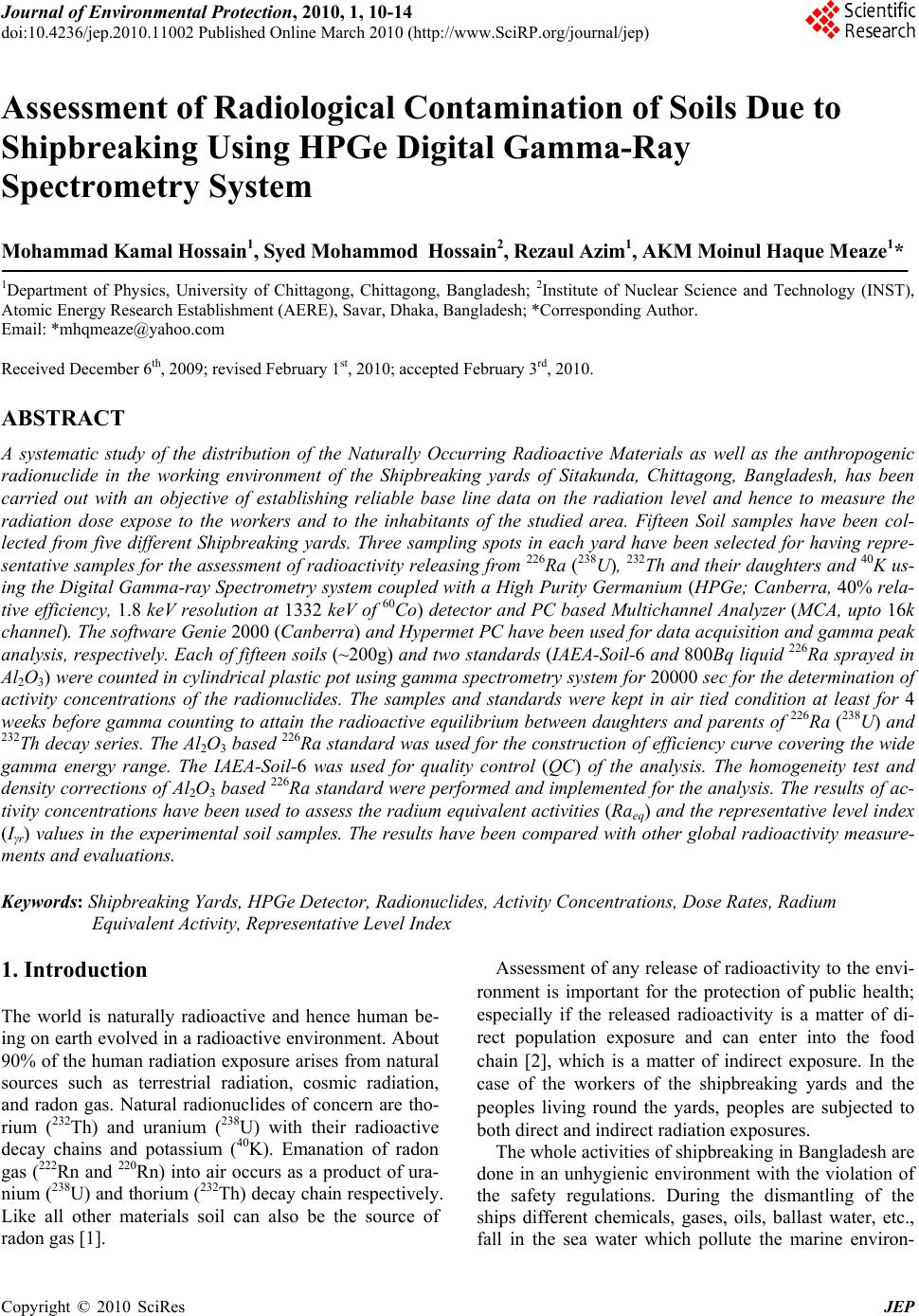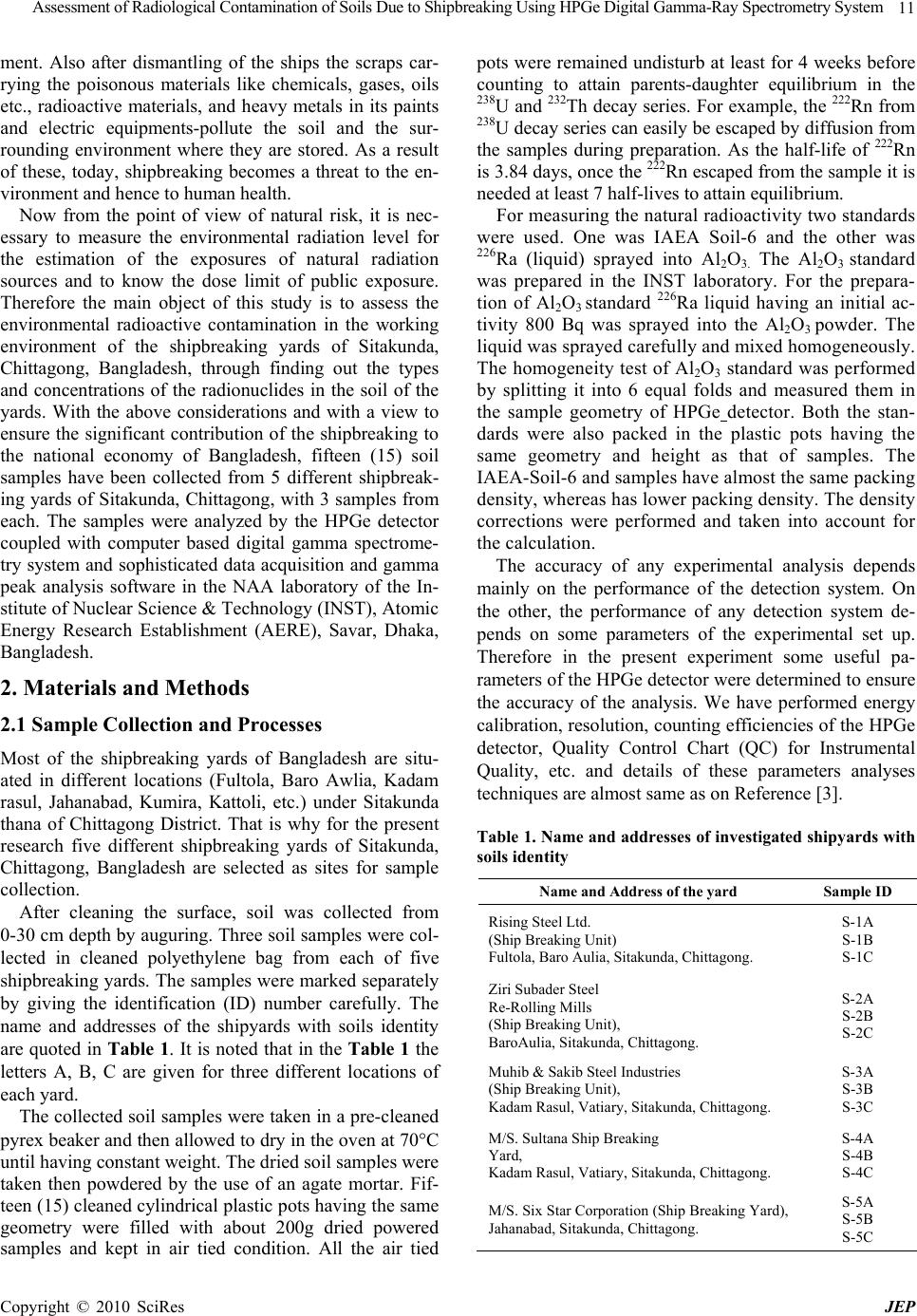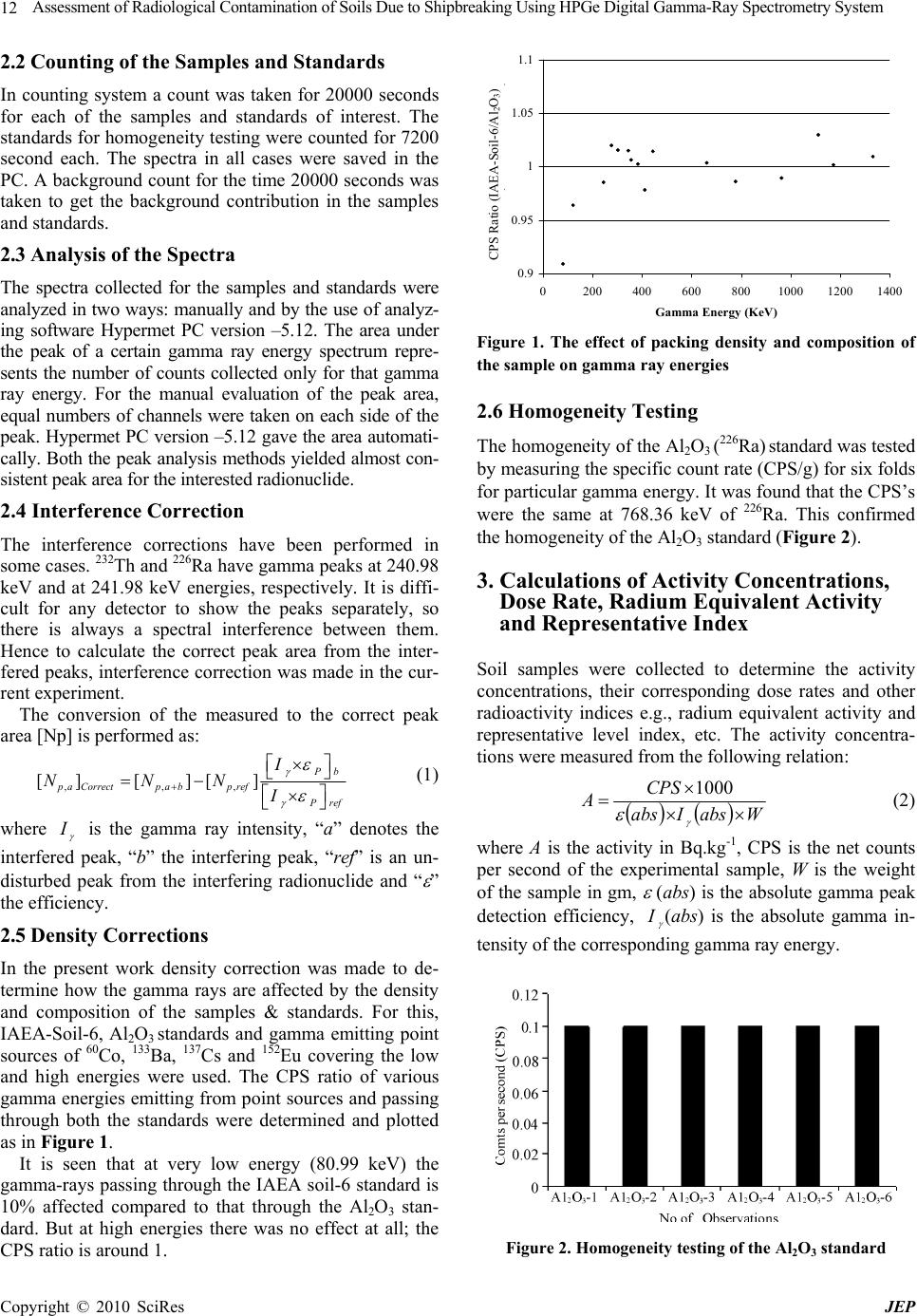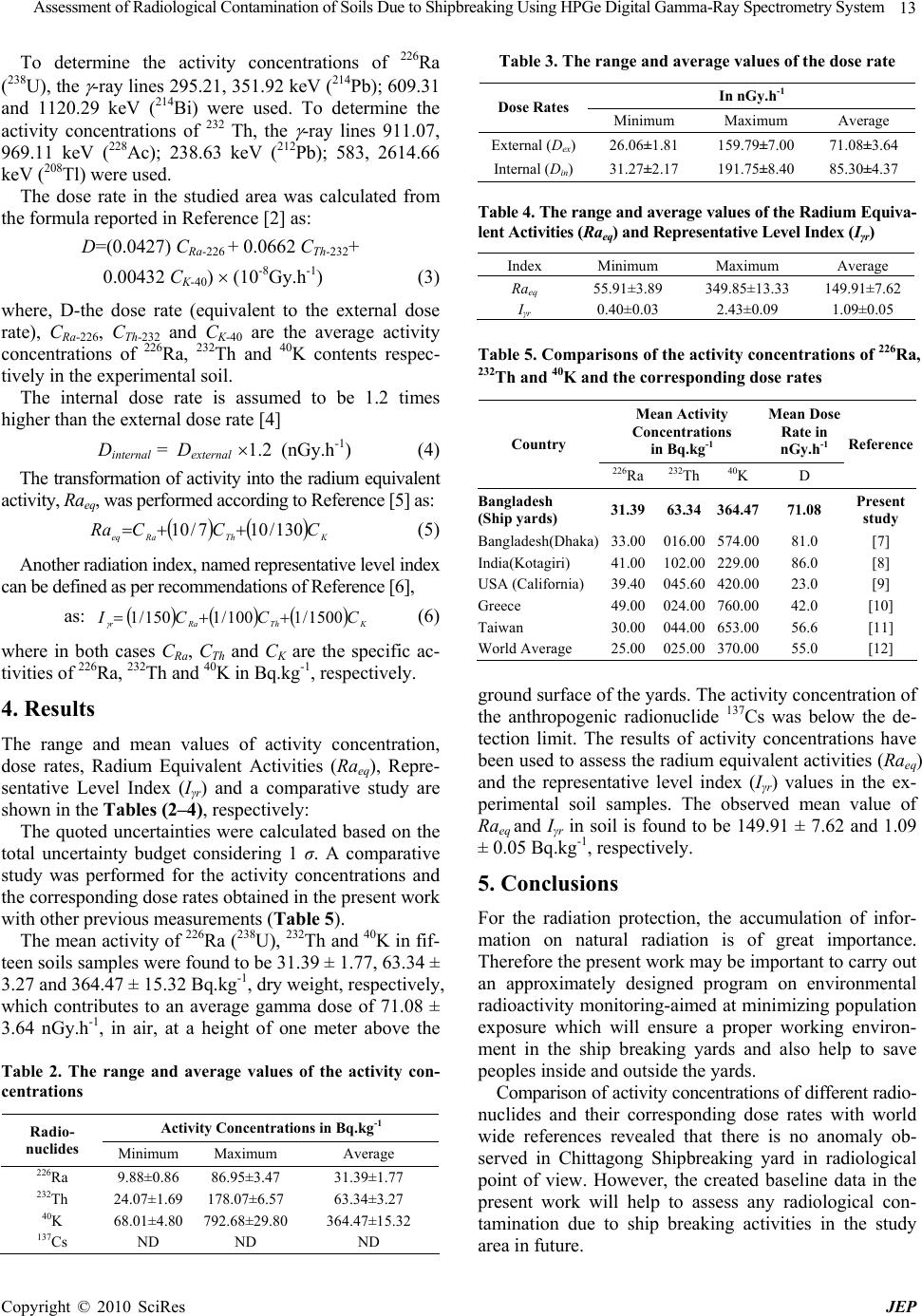Paper Menu >>
Journal Menu >>
 Journal of Environmental Protection, 2010, 1, 10-14 doi:10.4236/jep.2010.11002 Published Online March 2010 (http://www.SciRP.org/journal/jep) Copyright © 2010 SciRes JEP Assessment of Radiological Contamination of Soils Due to Shipbreaking Using HPGe Digital Gamma-Ray Spectrometry System Mohammad Kamal Hossain1, Syed Mohammod Hossain2, Rezaul Azim1, AKM Moinul Haque Meaze1* 1Department of Physics, University of Chittagong, Chittagong, Bangladesh; 2Institute of Nuclear Science and Technology (INST), Atomic Energy Research Establishment (AERE), Savar, Dhaka, Bangladesh; *Corresponding Author. Email: *mhqmeaze@yahoo.com Received December 6th, 2009; revised February 1st, 2010; accepted February 3rd, 2010. ABSTRACT A systematic study of the distribution of the Naturally Occurring Radioactive Materials as well as the anthropogenic radionuclide in the working environment of the Shipbreaking yards of Sitakunda, Chittagong, Bangladesh, has been carried out with an objective of establishing reliable base line data on the radiation level and hence to measure the radiation dose expose to the workers and to the inhabitants of the studied area. Fifteen Soil samples have been col- lected from five different Shipbreaking yards. Three sampling spots in each yard have been selected for having repre- sentative samples for the assessment of radioactivity releasing from 226Ra (238U), 232Th and their daughters and 40K us- ing the Digital Gamma-ray Spectrometry system coupled with a High Purity Germanium (HPGe; Canberra, 40% rela- tive efficiency, 1.8 keV resolution at 1332 keV of 60Co) detector and PC based Multichannel Analyzer (MCA, upto 16k channel). The software Genie 2000 (Canberra) and Hypermet PC have been used for data acquisition and gamma peak analysis, respectively. Each of fifteen soils (~200g) and two standards (IAEA-Soil-6 and 800Bq liquid 226Ra sprayed in Al2O3) were counted in cylindrical plastic pot using gamma spectrometry system for 20000 sec for the determination of activity concentrations of the radionuclides. The samples and standards were kept in air tied condition at least for 4 weeks before gamma counting to attain the radioactive equilibrium between daughters and parents of 226Ra (238U) and 232Th decay series. The Al2O3 based 226Ra standard was used for the construction of efficiency curve covering the wide gamma energy range. The IAEA-Soil-6 was used for quality control (QC) of the analysis. The homogeneity test and density corrections of Al2O3 based 226Ra standard were performed and implemented for the analysis. The results of ac- tivity concentrations have been used to assess the radium equivalent activities (Raeq) and the representative level index (Iγr) values in the experimental soil samples. The results have been compared with other global radioactivity measure- ments and evaluations. Keywords: Shipbreaking Yards, HPGe Detector, Radionuclides, Activity Concentrations, Dose Rates, Radium Equivalent Activity, Representative Level Index 1. Introduction The world is naturally radioactive and hence human be- ing on earth evolved in a radioactive environment. About 90% of the human radiation exposure arises from natural sources such as terrestrial radiation, cosmic radiation, and radon gas. Natural radionuclides of concern are tho- rium (232Th) and uranium (238U) with their radioactive decay chains and potassium (40K). Emanation of radon gas (222Rn and 220Rn) into air occurs as a product of ura- nium (238U) and thorium (232Th) decay chain respectively. Like all other materials soil can also be the source of radon gas [1]. Assessment of any release of radioactivity to the envi- ronment is important for the protection of public health; especially if the released radioactivity is a matter of di- rect population exposure and can enter into the food chain [2], which is a matter of indirect exposure. In the case of the workers of the shipbreaking yards and the peoples living round the yards, peoples are subjected to both direct and indirect radiation exposures. The whole activities of shipbreaking in Banglade sh are done in an unhygienic environment with the violation of the safety regulations. During the dismantling of the ships different chemicals, gases, oils, ballast water, etc., fall in the sea water which pollute the marine environ-  Assessment of Radiological Contamination of Soils Due to Shipbreaking Using HPGe Digital Gamma-Ray Spectrometry System Copyright © 2010 SciRes JEP 11 ment. Also after dismantling of the ships the scraps car- rying the poisonous materials like chemicals, gases, oils etc., radioactive materials, and heavy metals in its paints and electric equipments-pollute the soil and the sur- rounding environment where they are stored. As a result of these, today, shipbreaking becomes a threat to the en- vironment and hence to human health. Now from the point of view of natural risk, it is nec- essary to measure the environmental radiation level for the estimation of the exposures of natural radiation sources and to know the dose limit of public exposure. Therefore the main object of this study is to assess the environmental radioactive contamination in the working environment of the shipbreaking yards of Sitakunda, Chittagong, Bangladesh, through finding out the types and concentrations of the radionuclides in the soil of the yards. With the above considerations and with a view to ensure the significant contribution of the shipbreaking to the national economy of Bangladesh, fifteen (15) soil samples have been collected from 5 different shipbreak- ing yards of Sitak unda, Chittagong, with 3 samples from each. The samples were analyzed by the HPGe detector coupled with computer based digital gamma spectrome- try system and sophisticated data acquisition and gamma peak analysis software in the NAA laboratory of the In- stitute of Nuclear Science & Technology (INST), Atomic Energy Research Establishment (AERE), Savar, Dhaka, Bangladesh. 2. Materials and Methods 2.1 Sample Collection and Processes Most of the shipbreaking yards of Bangladesh are situ- ated in different locations (Fultola, Baro Awlia, Kadam rasul, Jahanabad, Kumira, Kattoli, etc.) under Sitakunda thana of Chittagong District. That is why for the present research five different shipbreaking yards of Sitakunda, Chittagong, Bangladesh are selected as sites for sample collection. After cleaning the surface, soil was collected from 0-30 cm depth by auguring. Three soil samples were col- lected in cleaned polyethylene bag from each of five shipbreaking yards. The samples were marked separately by giving the identification (ID) number carefully. The name and addresses of the shipyards with soils identity are quoted in Table 1. It is noted that in the Table 1 the letters A, B, C are given for three different locations of each yard. The collected soil samples were taken in a pre-cleaned pyrex beaker and then allowed to dry in the oven at 70C until having constant weight. The dried soil samples were taken then powdered by the use of an agate mortar. Fif- teen (15) cleaned cylindrical plastic pots having the same geometry were filled with about 200g dried powered samples and kept in air tied condition. All the air tied pots were remained undisturb at least for 4 weeks before counting to attain parents-daughter equilibrium in the 238U and 232Th decay series. For example, the 222Rn from 238U decay series can easily be escaped by diffusion from the samples during preparation. As the half-life of 222Rn is 3.84 days, once the 222Rn escaped from the sample it is needed at least 7 half-lives to attain equilibrium. For measuring the natural radioactivity two standards were used. One was IAEA Soil-6 and the other was 226Ra (liquid) sprayed into Al2O3. The Al2O3 standard was prepared in the INST laboratory. For the prepara- tion of Al2O3 standard 226Ra liquid having an initial ac- tivity 800 Bq was sprayed into the Al2O3 powder. The liquid was sprayed carefully and mixed homogeneously. The homogeneity test of Al2O3 standard was performed by splitting it into 6 equal folds and measured them in the sample geometry of HPGe detector. Both the stan- dards were also packed in the plastic pots having the same geometry and height as that of samples. The IAEA-Soil-6 and samples have almost the same packing density, whereas has lower packing density. The density corrections were performed and taken into account for the calculation. The accuracy of any experimental analysis depends mainly on the performance of the detection system. On the other, the performance of any detection system de- pends on some parameters of the experimental set up. Therefore in the present experiment some useful pa- rameters of the HPGe detector were determined to ensure the accuracy of the analysis. We have performed energy calibration, resolution, countin g efficiencies of the HPGe detector, Quality Control Chart (QC) for Instrumental Quality, etc. and details of these parameters analyses techniques are almost same as on Reference [3]. Table 1. Name and addresses of investigated shipyards with soils identity Name and Address of the yard Sample ID Rising Steel Ltd. (Ship Breaking Unit) Fultola, Baro Aulia, Sitakunda, Chittagong. S-1A S-1B S-1C Ziri Subader Steel Re-Rolling Mills (Ship Breaking Unit), BaroAulia, Sitakunda, Chittagong. S-2A S-2B S-2C Muhib & Sakib Steel Industries (Ship Breaking Unit), Kadam Rasul, Vatiary, Sitakunda, Chittagong. S-3A S-3B S-3C M/S. Sultana Ship Breaking Yard, Kadam Rasul, Vatiary, Sitakunda, Chittagong. S-4A S-4B S-4C M/S. Six Star Corporation (Ship Breaking Yard), Jahanabad, Sitakunda, Chittagong. S-5A S-5B S-5C  Assessment of Radiological Contamination of Soils Due to Shipbreaking Using HPGe Digital Gamma-Ray Spectrometry System Copyright © 2010 SciRes JEP 12 2.2 Counting of the Samples and Standards In counting system a count was taken for 20000 seconds for each of the samples and standards of interest. The standards for homogeneity testing were counted for 7200 second each. The spectra in all cases were saved in the PC. A background count for the time 20000 seconds was taken to get the background contribution in the samples and standards. 2.3 Analysis of the Spectra The spectra collected for the samples and standards were analyzed in two ways: manually and by the use of analyz- ing software Hypermet PC version –5.12. The area under the peak of a certain gamma ray energy spectrum repre- sents the number of counts collected only for that gamma ray energy. For the manual evaluation of the peak area, equal numbers of channels were taken on each side of the peak. Hypermet PC version –5.12 gave the area automati- cally. Both the peak analysis methods yielded almost con- sistent peak area for the int erested radionucli de. 2.4 Interference Correction The interference corrections have been performed in some cases. 232Th and 226Ra have gamma peaks at 240.98 keV and at 241.98 keV energies, respectively. It is diffi- cult for any detector to show the peaks separately, so there is always a spectral interference between them. Hence to calculate the correct peak area from the inter- fered peaks, interference correction was made in the cur- rent experiment. The conversion of the measured to the correct peak area [Np] is performed as: ,,, [][][ ] P b p aCorrectp abp ref P ref I NNN I (1) where I is the gamma ray intensity, “a” denotes the interfered peak, “b” the interfering peak, “ref” is an un- disturbed peak from the interfering radionuclide and “ ” the efficiency. 2. 5 Density Corrections In the present work density correction was made to de- termine how the gamma rays are affected by the density and composition of the samples & standards. For this, IAEA-Soil-6, Al2O3 standards and gamma emitting point sources of 60Co, 133Ba, 137Cs and 152Eu covering the low and high energies were used. The CPS ratio of various gamma energies emitting from point sources and passing through both the standards were determined and plotted as in Figure 1. It is seen that at very low energy (80.99 keV) the gamma-rays passing through the IAEA soil-6 standard is 10% affected compared to that through the Al2O3 stan- dard. But at high energies there was no effect at all; the CPS ratio is around 1. 0.9 0.95 1 1.05 1.1 0200 400 600 800100012001400 Gamma Energy (KeV) CPS Ratio (IAEA-Soil-6/Al2O3) CPS Ra tio (IAEA -So il-6/A l 2 O 3 ) Figure 1. The effect of packing density and composition of the sample on gamma ray energies 2.6 Homogeneity Testing The homogeneity of the Al2O3 (226Ra) standard was tested by measuring the specific count rate (CPS/g) for six folds for particular gamma energy. It was found that the CPS’s were the same at 768.36 keV of 226Ra. This confirmed the homogeneity of the Al2O3 standard (Figure 2). 3. Calculations of Activity Concentrations, Dose Rate, Radium Equivalent Activity and Representative Index Soil samples were collected to determine the activity concentrations, their corresponding dose rates and other radioactivity indices e.g., radium equivalent activity and representative level index, etc. The activity concentra- tions were measured from the following relation: WabsIabs CPS A 1000 (2) where A is the activity in Bq.kg-1, CPS is the net counts per second of the experimental sample, W is the weight of the sample in gm, (abs) is the absolute gamma peak detection efficiency, I(abs) is the absolute gamma in- tensity of the corresponding gamma ray energy. Figure 2. Homogeneity testing of the Al2O3 standard  Assessment of Radiological Contamination of Soils Due to Shipbreaking Using HPGe Digital Gamma-Ray Spectrometry System Copyright © 2010 SciRes JEP 13 To determine the activity concentrations of 226Ra (238U), the -ray lines 295.21, 351.92 keV (214Pb) ; 609.31 and 1120.29 keV (214Bi) were used. To determine the activity concentrations of 232 Th, the -ray lines 911.07, 969.11 keV (228Ac); 238.63 keV (212Pb); 583, 2614.66 keV (208Tl) were used. The dose rate in the studied area was calculated from the formula reported in Reference [2] as: D=(0.0427) CRa-226 + 0.0662 CTh-232+ 0.00432 CK-40) (10-8Gy.h-1) (3) where, D-the dose rate (equivalent to the external dose rate), CRa-226, CTh-232 and CK-40 are the average activity concentrations of 226Ra, 232Th and 40K contents respec- tively in the experimental soil. The internal dose rate is assumed to be 1.2 times higher than the external dose rate [4] Dinternal = Dexternal 1.2 (nGy.h-1) (4) The transformation of activity into the radium equivalent activity, Raeq, was performed according to Reference [5] as: KThRaeq CCCRa 130/107/10 (5) Another radiation index, named representative level index can be de fined as per rec omm endation s of Refe rence [ 6], as: KThRar CCCI 1500/1100/1150/1 (6) where in both cases CRa, CTh and CK are the specific ac- tivities of 226Ra, 232Th and 40K in Bq.kg-1, respectively. 4. Results The range and mean values of activity concentration, dose rates, Radium Equivalent Activities (Raeq), Repre- sentative Level Index (Iγr) and a comparative study are shown in the Tables (2–4), respectively: The quoted uncertainties were calculated based on the total uncertainty budget considering 1 σ. A comparative study was performed for the activity concentrations and the corresponding dose rates obtained in the present work with other previous measurements (Table 5). The mean activity of 226Ra (238U), 232Th and 40K in fif- teen soils samples were found to be 31.39 ± 1.77, 63.34 ± 3.27 and 364.47 ± 15.32 Bq.kg-1, dry weight, respectively, which contributes to an average gamma dose of 71.08 ± 3.64 nGy.h-1, in air, at a height of one meter above the Table 2. The range and average values of the activity con- centrations Table 3. The range and average values of the dose rate In nGy.h-1 Dose Rates Minimum Maximum Average External (Dex) 26.06±1.81 159.79±7.00 71.08±3.64 Internal (Din) 31.27±2.17 191.75±8.40 85.30±4.37 Table 4. The range and average values of the Radium Equiva- lent Activities (Raeq) and Representative Level Index (Iγr) Index Minimum Maximum Average Raeq 55.91±3.89 349.85±13.33 149.91±7.62 Iγr 0.40±0.03 2.43±0.09 1.09±0.05 Table 5. Comparisons of the activity concentrations of 226Ra, 232Th and 40K and the corresponding dose ra tes Mean Activity Concentrations in Bq.kg-1 Mean Dose Rate in nGy.h-1 Country 226Ra 232Th 40K D Reference Bangladesh (Ship yards) 31.3963.34 364.47 71.08 Present study Bangladesh(Dhaka)33.00016.00 574.00 81.0 [7] India(Kotagiri) 41.00102.00 229.00 86.0 [8] USA (California) 39.40045.60 420.00 23.0 [9] Greece 49.00024.00 760.00 42.0 [10] Taiwan 30.00044.00 653.00 56.6 [11] World Average 25.00025.00 370.00 55.0 [12] ground surface of th e yards. The activity concentration of the anthropogenic radionuclide 137Cs was below the de- tection limit. The results of activity concentrations have been used to assess the radium equivalent activities (Raeq) and the representative level index (Iγr) values in the ex- perimental soil samples. The observed mean value of Raeq and Iγr in soil is found to be 149.91 ± 7.62 and 1.09 ± 0.05 Bq.kg-1, respectively. 5. Conclusions For the radiation protection, the accumulation of infor- mation on natural radiation is of great importance. Therefore the present work may be important to carry out an approximately designed program on environmental radioactivity monitoring-aimed at minimizing popu lation exposure which will ensure a proper working environ- ment in the ship breaking yards and also help to save peoples inside and outside the yards. Comparison of activity concentrations of different radio- nuclides and their corresponding dose rates with world wide references revealed that there is no anomaly ob- served in Chittagong Shipbreaking yard in radiological point of view. However, the created baseline data in the present work will help to assess any radiological con- tamination due to ship breaking activities in the study area in future. Activity Concentrations in Bq.kg-1 Radio- nuclides Minimum Maximum Average 226Ra 9.88±0.86 86.95±3.47 31.39±1.77 232Th 24.07±1.69 178.07±6.57 63.34±3.27 40K 68.01±4.80 792.68±29.80 364.47±15.32 137Cs ND ND ND  Assessment of Radiological Contamination of Soils Due to Shipbreaking Using HPGe Digital Gamma-Ray Spectrometry System Copyright © 2010 SciRes JEP 14 6. Acknowledgement The corresponding author A. K. M. Moinul Haque Meaze would like to express his sincere thanks and ac- knowledge to the Bangladesh University Grants Com- mission (UGC) for providing fund to carry out this Project in the fiscal year 2008–2009. The corresponding author and Project Director also would like to thanks to the Au- thority of the University of Chittagong, Bangladesh to select his project for obtaining grants from the UGC. The authors would like to thanks to the authorities of different shipbreaking yards for their excellent cooperation. REFERENCES [1] N. A. Matiullah and A. J. A. H. Khatibeh, “Comparative studies of indoor radon concentration levels in Jordan us- ing CR-39 based bag and cup dosimeter,” Health Physics, Vol. 75, No. 1, pp. 60–62, 1998. [2] IAEA Technical Report Series, “Measurement of ra- dio-nuclides in food and the environment,” No. 295, 1989. [3] K. A. Kabir, S. M. A. Islam, and M. M. Rahman, “Dis- tribution of radionuclides in surface soil and bottom sedi- ment in the district of Jessore, Bangladesh and evaluation of radiation hazard,” Journal of Bangladesh Academy of Sciences, Vol. 33, No. 1, pp. 117–130, 2009. [4] United Nations Scientific Committee on the Effects of Atomic Radiation Report to the General Assembly, 1998. http://www.unscear.org/unscear/en/publications/1988.html [5] J. Beretka and P. J. Mathew, “Natural radioactivity of Australian building materials, industrial wastes and by- products,” Health Physics, Vol. 48, No. 1, pp. 87–95, 1985. [6] Report by NEA Group of Experts, “Nuclear energy agency, exposure to radiation from natural radioactivity in building materials,” OECD, 1979. [7] F. K. Mia, S. Roy, N. Touhiduzzaman, and B. Alan, “Dis- tribution of radionuclides in soil samples in and around Dhaka city,” Applied Radiation and Isotopes, Vol. 49, No. 1–2, pp. 133–137, 1998. [8] S. Selvasekarapandian, N. M. Manikandan, R. Sivkumar, V. Meenakshinundaram, and V. Raghunath, “Natural ra- diation distribution of soils at Kotagiri Taluk of the Nilgiris biosphere in India,” Radio-Analytical and Nu- clear Chemistry, Vol. 252, No. 2, pp. 429–435, 2002. [9] J. G. Ingersoll, “A survey of radionuclide contents and radon emanation rates in building materials used in the U. S.,” Health Physics, Vol. 45, No. 2, pp. 362–368, 1983. [10] C. Papastefanou, S. Stoulos, M. Manolopoulou, A. Ioan- nidou, and S. Charalambous, “Indoor radon concentra- tions in Greek apartment dwellings,” Health Physics, Vol. 66, No. 3, pp. 270–273, 1994. [11] C. J. Chen, P. S. Weng, and T. C. Chu, “Evaluation of natural radiation in houses built with black schist,” Health Physics, Vol. 64, No. 1, pp. 74–78, 1983. [12] M. Shohag, “Measurement of the natural and artificial radio activity in soil of Mymensingh district of Bangla- desh,” M. S. Thesis, University of Chittagong, Bangla- desh, 2007. |

